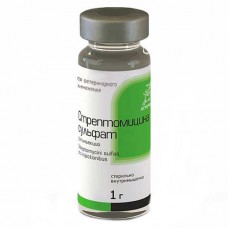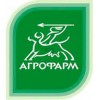Expiration date: 01/2026
Streptomycin sulfate is a drug for the treatment of leptospirosis, tularemia, pneumonia, diplococcal infections, mastitis, endometritis, endocarditis, meningitis, wound and postpartum sepsis, erysipelas and edematous disease of pigs, malignant catarrhal fever, campylobacteriosis and actinomycosis of cattle and other diseases whose pathogens are sensitive to streptomycin.
STRUCTURE
The preparation is a salt of an organic base produced by the microscopic radiant fungus Streptomyces globisporus streptomycini. Powder (or porous mass) white color, odorless, bitter taste, hygroscopic, easily soluble in water, saline solution and novocaine solution. It is stable in a slightly acidic environment. It is destroyed in solutions of strong acids and alkalis when heated. They are produced in vials of 1g in terms of streptomycin base.
PHARMACOLOGICAL PROPERTIES
Streptomycin has a bacteriostatic and bactericidal effect against many Gram-positive and Gram-negative pathogenic microbes. The antimicrobial activity of streptomycin is associated with inhibition of protein synthesis at the level of ribosomes in the microbial cell. Streptomycin is not effective in infections caused by Clostridia and other anaerobic microorganisms, plasmodia, fungi, rickettsias and viruses. Some microorganisms develop resistance to streptomycin, and reproducing microbes may develop resistance to the antibiotic within a few days. Resistant strains mostly develop by the end of the second month of treatment, but can develop in a few days. To prevent this and eliminate the infection, large doses of streptomycin should be used as soon as possible and combined with other antimicrobial agents.
When streptomycin sulfate is administered orally, it is practically not absorbed by the mucous membrane of the gastrointestinal tract and is almost completely excreted through the intestine. When administered intramuscularly, it is rapidly absorbed into the blood and is found in the peritoneal and pleural cavities, in the vitreous body of the eye, in bile, in urine. In the pleural cavity, especially in acute inflammatory processes, the concentration of the antibiotic can reach up to 50% of the level in the blood.
In meningitis, streptomycin penetrates the spinal canal in large amounts of 10-50% of the blood level. It easily passes through the placenta. In normal liver function, streptomycin accumulates in high concentrations in the bile of the hepatic tubules. With impaired liver function, it enters the bile in small amounts; with cholecystitis, the content of streptomycin in the gallbladder is 70-80% of its level in the blood. The therapeutic concentration in various organs and tissues of the body is maintained for 8-12 hours. Streptomycin is rapidly eliminated from the body: 50-60% - in the urine within 12-24 hours. If the excretory function of the kidneys is impaired, the excretion of streptomycin slows down.
INDICATIONS
Leptospirosis, tularemia, pneumonia, diplococcal infections, mastitis, endometritis, endocarditis, meningitis, wound and postpartum sepsis, erysipelas and swine edematous disease, malignant catarrhal fever, bovine campylobacteriosis and actinomycosis, and other diseases whose pathogens are sensitive to streptomycin.
APPLICATION
Immediately before use, the drug is dissolved in sterile water, saline solution or 0.25-0.5% novocaine solution at the rate of 0.25 g of streptomycin per 1 ml of solvent (0.5 g in 2.5 ml, and 1g in 5 ml); more concentrated solutions are painful; glucose solutions are not used as a solvent.
The prepared solution can be stored for 7 days at room temperature, but it is better in the refrigerator.
Streptomycin sulfate solution is administered mainly intramuscularly, also used topically, inside, externally,intratracheal, intracavitary, intravenous, intraperitoneal, intrauterine. Intramuscular injections are made deep into the muscle. Treatment is carried out within 4-7 days. The drug is administered 2 times a day at intervals of 12 hours.
In leptospirosis, streptomycin sulfate is administered for 4-10 days at a dose of 25 mg / kg, in severe cases, the dose can be further increased. Streptomycin sulfate can be combined with penicillin, polymixin, and sulfonamide preparations. Their combination shows a synergistic effect and prevents the rapid appearance of resistant forms of pathogens to streptomycin.
SIDE EFFECTS
When administered intramuscularly, cattle sometimes exhibit rapidly developing allergic reactions (anaphylactic shock, angioedema of the larynx), which can pose a threat to the animal's health. The occurrence of these complications is associated with the individual characteristics of the animal body and does not depend on the dose of the administered antibiotic. Complications may occur after the first administration of the drug, but are more often caused by sensitization of the body with repeated courses of treatment. When allergic reactions occur, animals are injected with norepinephrine, epinephrine, calcium chloride, antihistamines, corticosteroids. When treated with streptomycin, various toxic reactions, tachycardia, diarrhea, dermatitis, movement coordination disorders can also be observed, and long-term use of large doses can develop deafness.
CONTRAINDICATIONS
Hypersensitivity to aminoglycoside antibiotics. Renal and cardiovascular insufficiency. The combined use of streptomycin sulfate with other aminoglycoside drugs (neomycin, kanamycin, monomycin, gentamicin) is not allowed due to the possible increase in the nephrotoxic effect.
SPECIAL INSTRUCTIONS
Contact dermatitis may develop in individuals who have been exposed to streptomycin for a long time. Some authors do not recommend mixing streptomycin sulfate with penicillin in one syringe, while others are opposed to this combination, while some specialists successfully use this combination. Slaughter of animals is allowed 7 days after the last use of the drug. The meat of animals that were forcibly killed earlier than the specified period can be used for the production of meat and bone meal. Milk for food purposes can be consumed 48 hours after the last administration of the drug. Milk obtained earlier than the specified period can be used for feeding animals.
SHELF LIFE AND STORAGE
Store in a dry, dark place at room temperature. Shelf life — 3 years.
PACKAGING
The drug is released packaged in 1g in glass vials.


